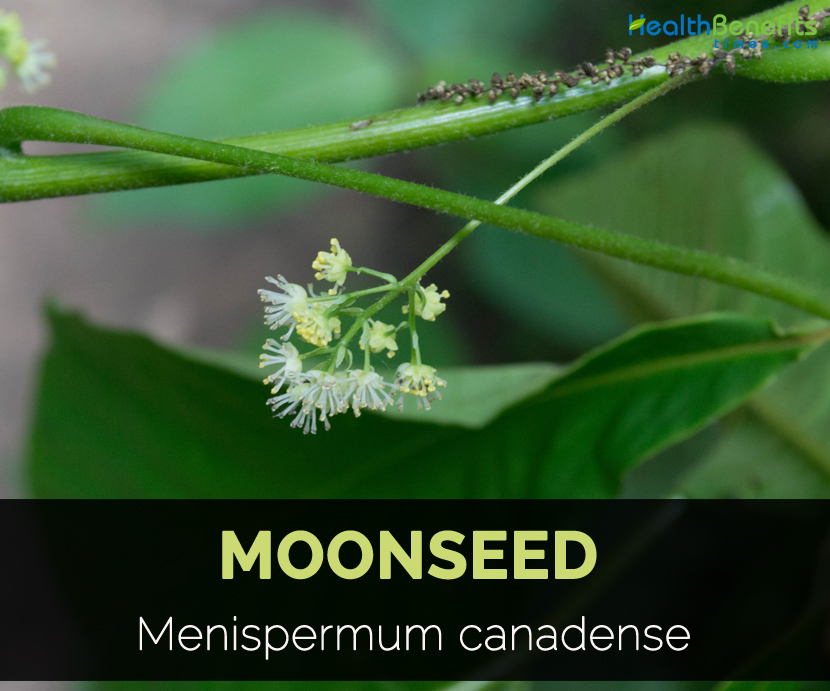| Moonseed Quick Facts | |
|---|---|
| Name: | Moonseed |
| Scientific Name: | Menispermum canadense |
| Origin | Native to eastern North America, from southern Canada south to northern Florida, and from the Atlantic coast west to Manitoba and Texas. |
| Name | Moonseed |
|---|---|
| Scientific Name | Menispermum canadense |
| Native | Native to eastern North America, from southern Canada south to northern Florida, and from the Atlantic coast west to Manitoba and Texas. |
| Common/English Name | Yellow parilla, Vine-Maple, Texas Sarsaparilla, Canadian Moonseed, Yellow Sarsaparilla, Common moonseed |
| Name in Other Languages | English: Canadian moonseed, Common moonseed, Moonseed, Yellow parilla, Canada moonseed, Moonseed vine; Swedish: Amerikansk månfröranka; French: Ménisperme du Canada |
| Plant Growth Habit | Woody climbing vine |
| Plant Size | 6 m tall |
| Stem | Green to brownish red and slightly hairy |
| Leaf | Palmately lobed, 5–20 cm diameter |
| Flowering Season | Late spring to early summer |
| Flower | Dark green, heart-shaped, 5 inches (12.7 cm) long |
| Fruit shape & size | Berry, 1–1.5 cm in diameter |
| Fruit color | Purple-black |
| Fruit Season | September and October |
| Medicinal part | The root |
Seed are crescent moon about 6-10 mm across, light tan to brown to gray. Seedlings are long thin cotyledons but typically shaped first true leaf.
Leaves and stems
Leaves are alternate measuring 3 to 8 inches long and heart shaped at the base with 7 to 12 primary veins radiating from the base. The edges of leaf are toothless and have 3 to 7 shallow lobes. The lobe tips are rounded to bluntly pointed. Upper surface is medium to dark green, hairless or becoming hairless. Lower surface is paler, finely hairy especially along the veins. Leaf stalks are 8 inches long and attached on underside near but not at the base of the leaf.
Uses
“Yellow Parilla seems to possess one virtue which is paramount to all others, it is essentially and particular antisyphilitic, anti-scrofulous, anti-mercurial.” Achieving this, it is of much merit for all diseases arising from either hereditary or acquired impurities of the system. It exerts its influence principally on the gastric and salivary glands and is found expressly beneficial in cases of adhesive inflammation and where it is found necessary to break up organized deposits and hasten disintegration of unwanted tissue. It is believed by some to be superior to Sarsaparilla as a blood purifier for scrofula, blood disorders, gout, rheumatism and cutaneous skin diseases generally. Also acts as a tonic and nervine and may be given in all cases of debility and dyspepsia.
Dose
1 teaspoonful to 1 cupful of boiling water, steeped 15 min.; take 1–4 cupfuls a day. Of the tincture, 5–20 min. Of the powder, 1–4 grains. If it produces vomiting, reduce the dosage.
Homoeopathic Clinical
Tincture of the root; trituration of menisperminum—Back ache, Headache, Itching, Tongue (swelling of).
Medicinal uses
- Apply the root externally as salve on chronic sores.
- Cherokee use moonseed as a laxative.
- Use the root for skin diseases.
- Lenape use it in salve for treating skin sores.
- Use the root tea for treating indigestion, bowel disorders, arthritis and as a blood cleanser.
- Apply the root externally as a salve on chronic sores.
References:
https://www.itis.gov/servlet/SingleRpt/SingleRpt?search_topic=TSN&search_value=18871#null
https://pfaf.org/user/Plant.aspx?LatinName=Menispermum+canadense
https://en.wikipedia.org/wiki/Menispermum_canadense
http://climbers.lsa.umich.edu/?p=474
https://nurserylive.com/en/shop/menispermum-canadense-plants-in-india?tmpl=component&format=pdf
http://temperate.theferns.info/plant/Menispermum+canadense
https://www.minnesotawildflowers.info/shrub/canada-moonseed
http://www.naturalmedicinalherbs.net/herbs/m/menispermum-canadense=canada-moonseed.php
http://medicinalherbinfo.org/000Herbs2016/1herbs/canada-moonseed/
Comments
comments
